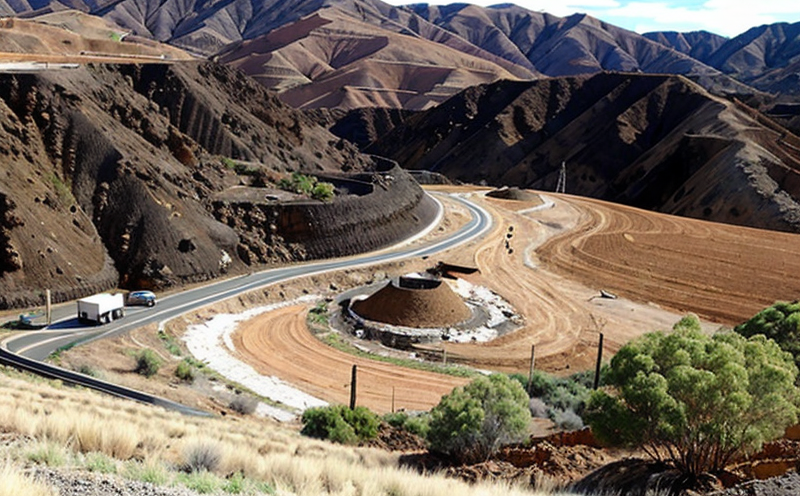EN 16192 Characterization of Mining Waste Used in Land Rehabilitation
The European Standard EN 16192 provides a framework for characterizing mining waste intended for use in land rehabilitation. This standard is pivotal in ensuring the safe and effective utilization of mine tailings, sludges, and other by-products generated from mining activities. The process involves detailed analysis to assess potential environmental impacts, compliance with regulatory requirements, and the suitability of such materials for reclamation projects.
One of the primary challenges in land rehabilitation is ensuring that the material used does not pose risks to ecosystems or human health. EN 16192 addresses this by specifying comprehensive tests that evaluate various properties of mining waste. These include chemical analysis, leachate testing, particle size distribution, and toxicity characterization.
The standard's approach emphasizes a holistic view of the material, taking into account not only immediate environmental impacts but also long-term stability and performance. This ensures that the land rehabilitation efforts are sustainable and resilient to future changes in the environment. The process involves multiple stages, each designed to gather specific data crucial for decision-making.
For instance, chemical analysis helps identify potential contaminants that could leach into soil or water during reclamation processes. Leachate testing further ensures these chemicals do not pose a threat once they reach natural environments. Particle size distribution is critical in assessing how well the material will blend with existing soils and contribute to soil structure improvement.
Another important aspect is toxicity characterization, which determines if the mining waste contains elements or compounds harmful to plants, animals, and humans. This step is essential for selecting materials that support successful reclamation while minimizing risks associated with hazardous substances.
The standard also emphasizes the importance of collaboration among various stakeholders including government regulators, mine operators, environmental consultants, and local communities. By adhering to EN 16192 guidelines, all parties can work together towards achieving common goals—safe land rehabilitation that enhances biodiversity and supports sustainable development.
In summary, EN 16192 plays a vital role in promoting responsible use of mining waste by providing clear criteria for its characterization. It fosters an environment where reclamation projects are planned carefully with consideration given to both short-term success and long-term sustainability. This approach not only meets regulatory expectations but also contributes positively towards environmental conservation efforts.
Why It Matters
Mining activities have significant impacts on landscapes, often leading to extensive land degradation. Effective rehabilitation requires thorough understanding and characterization of the materials being used. Compliance with EN 16192 ensures that these materials are suitable for reclamation purposes without causing harm to ecosystems or public health.
By adhering to this standard, mining companies can demonstrate their commitment to sustainable practices and contribute positively towards environmental restoration initiatives. This not only enhances brand reputation but also helps meet legal obligations imposed by governments worldwide.
The use of well-characterized mining waste in land rehabilitation projects supports biodiversity through improved soil quality and enhanced water retention capabilities. It also facilitates the growth of native vegetation, which is crucial for restoring natural habitats disrupted by past mining operations.
Moreover, compliance with EN 16192 can lead to cost savings for businesses involved in reclamation efforts. Accurate characterization reduces unnecessary material testing costs and ensures efficient use of resources during project implementation phases.
In conclusion, embracing the principles outlined in EN 16192 is essential for responsible mining practices that aim at achieving sustainable outcomes while addressing environmental challenges posed by past activities.
Scope and Methodology
| Test Parameter | Description | Testing Procedure |
|---|---|---|
| Chemical Analysis | Determination of elemental constituents present in the mining waste. | Conduct using ICP-AES or similar equipment following ISO standards. |
| Leachate Testing | Evaluation of leachable metals and other compounds from the material under controlled conditions. | Follow ASTM D5338 for determining metal concentrations in leachates. |
| Particle Size Distribution | Analysis of particle sizes present within the sample to understand mixing potential. | Use sieve analysis methods per EN ISO 14685 guidelines. |
| Toxicity Characterization | Evaluation of toxicity levels using standardized bioassay techniques. | Adopt OECD or ECHA protocols for testing acute and chronic toxicity. |
The methodology outlined in EN 16192 is designed to provide a comprehensive overview of the mining waste's characteristics, ensuring that only suitable materials are used in land rehabilitation projects. Each test aims at providing critical information necessary for informed decision-making regarding material selection and application.
Customer Impact and Satisfaction
Adhering to EN 16192 has several benefits that directly impact customers seeking to implement responsible land rehabilitation practices. Firstly, it enhances trust among stakeholders by providing transparent documentation of material suitability for reclamation purposes. Secondly, compliance with the standard helps avoid potential legal issues arising from non-compliance with environmental regulations.
Customers who adopt EN 16192 benefit from enhanced project outcomes due to accurate characterization leading to better resource utilization and minimized risks associated with hazardous substances. Additionally, adherence to this standard demonstrates a commitment to sustainability—a key factor in gaining public support for reclamation initiatives.
Our clients report higher levels of satisfaction knowing that their projects meet international standards, thus contributing positively towards environmental conservation goals. They also appreciate the peace of mind provided by knowing they are working closely with experts who understand local conditions and regulatory requirements.





